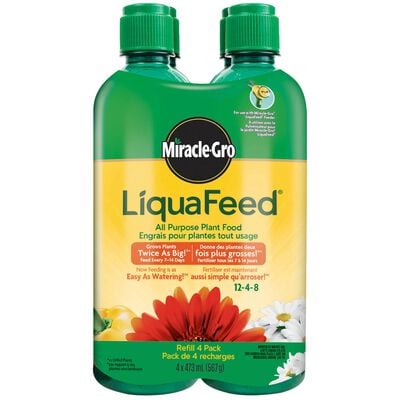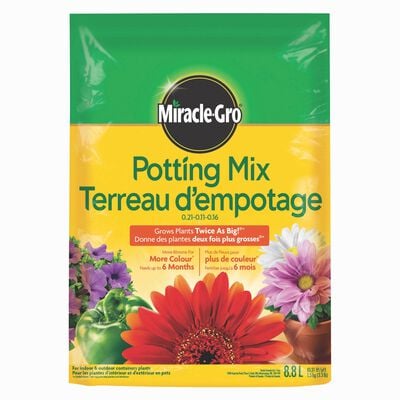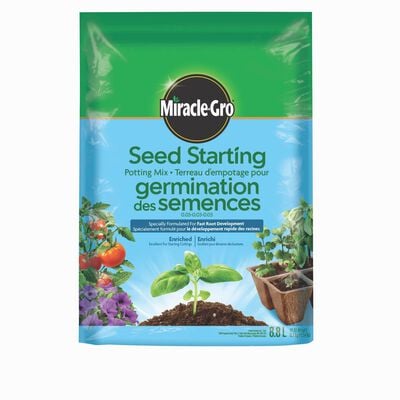
How to Grow Basil
- Plant basil in a spot that gets 6-8 hours of sun daily. In the South, give your plants afternoon shade.
- Once plants are 4-6 inches tall, pinch off the top-most branches to encourage more side shoots. Also, pinch blooms to prevent basil from going to seed.
- Check soil often and water when the top inch is dry.
- Add 3 inches of mulch to help maintain soil moisture and block weeds.
- Feed basil plants regularly with MIracle-Gro® Liquafeed® All Purpose Plant Food one month after planting.
- You can start harvesting when your plant is 6-8 inches tall.
Basil is an annual herb that thrives when summer heat arrives, pumping out fragrantly delicious leaves. Planting basil typically yields a harvest of leaves flavored with hints of anise, mint, and clove, but you can also try growing basil with tones of cinnamon or lemon. You'll find leaves in a variety of sizes, flavors and colors. If you like cooking Italian and Asian cuisine, you should try growing basil.
Here's how to grow basil in your home garden.
Prep
Basil is a tropical herb, and plants need sun and heat to thrive. Give it a spot that receives six to eight hours of sun daily, except in the South and Southwest, where afternoon shade is a must.
Basil needs moist, nutrient-rich soil that drains well. Here's how to make sure you're getting the best growing environment possible: If you plan to plant basil in in-ground planting beds, mix 3 inches of aged compost-enriched Miracle-Gro® Garden Soil All Purpose 0.09 - 0.05 - 0.07 into the top 6 inches of soil where your basil patch will be. Fill containers with Miracle-Gro® Potting Mix 0.21 - 0.11 - 0.16, which also contains compost but is lighter and fluffier than garden soil-perfect for pots. In raised beds, blend equal parts of in-ground soil and container mix, or use Miracle-Gro® Organics Garden Mix for Vegetables and Herbs.
Plant
The fastest way to reach harvest time when growing basil is to plant young plants. You can actually begin harvesting immediately after planting!
If you would prefer to grow seeds, sow them directly into soil outdoors after all danger of frost has passed, or start seeds indoors about six to eight weeks before your region's average last frost date, using Miracle-Gro® Seed Starting Potting Mix 0.03 - 0.03 - 0.03. Sow basil seeds one-half inch deep, placing 3 seeds per seed-starting cell. Germination takes 7 to 14 days. After the first set of true leaves appear (these will be teardrop-shaped), thin seedlings by using scissors to snip off all but the strongest seedling in each cell. If necessary, transplant seedlings into larger containers until they're ready to go into the garden. In the garden, space plants 12 to 18 inches apart, depending on variety. If starting seeds directly in the garden, sow seeds one-half inch deep, one inch apart, and thin to 12-18 inches apart after the first set of true leaves appears. If growing in a pot, choose a 12-inch container or larger.
Water well after planting.
Grow
Pinch basil plants when they're 4 to 6 inches tall, removing the center set of leaves at the growing tip. This will encourage branching, resulting in a bushier plant. Pinch basil shoots again when they have added another 6 inches of growth.
Basil plants need consistent soil moisture to yield well. When the top inch of the soil is dry, you need to water. Containers need to be watered more frequently than in-ground gardens.
Mulch around plants with 2 to 3 inches of Scotts® Nature Scapes® bagged mulch, straw, shredded leaves, pine straw, or untreated grass clippings. Mulch helps reduce weeds and keep soil moist, which can reduce watering chores.
Basil plants need a steady supply of plant food to work in tandem with high quality soil to fuel leaf production. Starting about a month after planting, feed both your plants and the soil with MIracle-Gro® Liquafeed® All Purpose Plant Food, following the directions on the label. Continue to feed plants every 1 to 2 weeks throughout the growing season.
Sometime around mid-summer, plants will start flowering. As soon as you see a flower bud, pinch it off. If flowers are allowed to grow, leaf flavor will change (not for the better) and leaf production will start to slow.
Basil is extremely cold-sensitive, typically showing signs of cold damage at temperatures below 42°F. Harvest plants heavily if frost is in the forecast.
Harvest
Start harvesting individual leaves as soon as plants are 6 to 8 inches high. Pinch individual leaves or snip stems. To store basil inside for a few days, keep freshly clipped sprigs in a vase of water at room temperature. Do not refrigerate basil; the cold air turns leaves brown.
You can, however, freeze chopped basil in cubes of water or olive oil.
Use
Basil is a go-to herb for Italian, Mediterranean, and Asian cuisines. Use leaves to flavor tomato sandwiches, pizza, or in salads. or sauces. Cinnamon and lemon basil make terrific additions to fresh fruit blends and smoothies. Thai basil blends beautifully with Southeast Asian recipes like stir-fries, marinades, and chutney.
When using basil in recipes, tear instead of chopping to release oils and achieve maximum flavor in your dishes. For best flavor, add it to hot dishes right before serving.
Ready to start planting and growing your own basil? Click on any of the product links above for more information, to purchase the product online, or to find a retailer near you.


